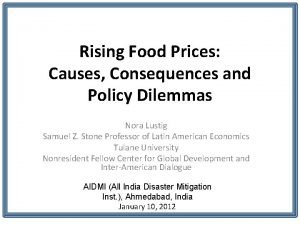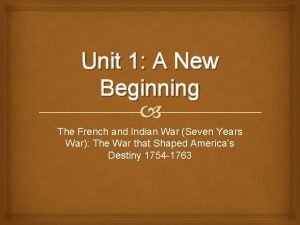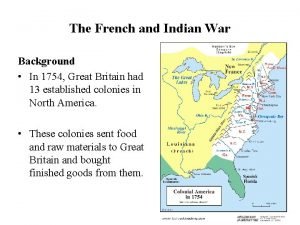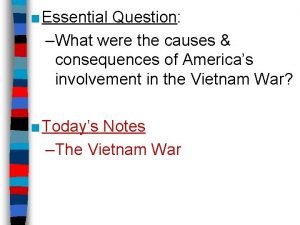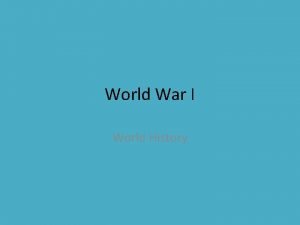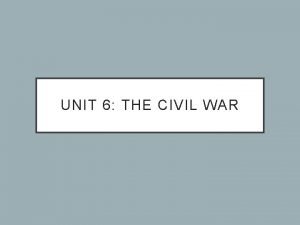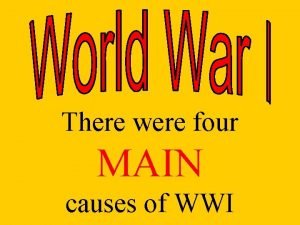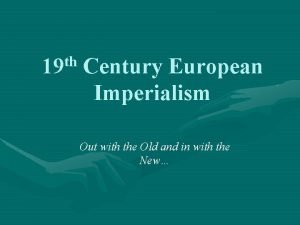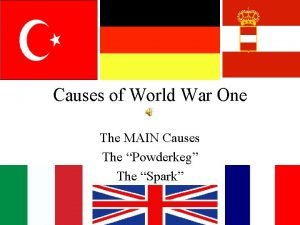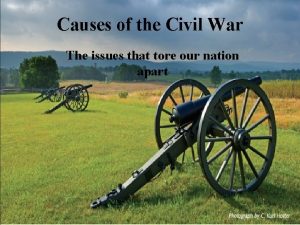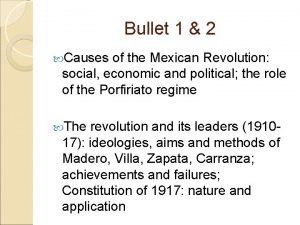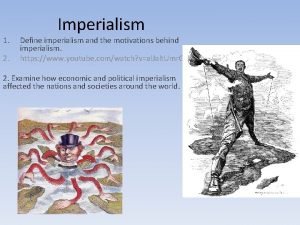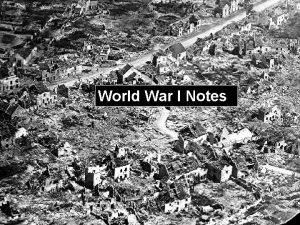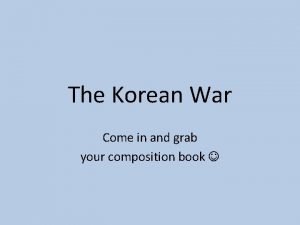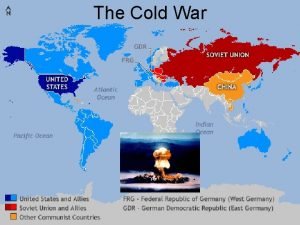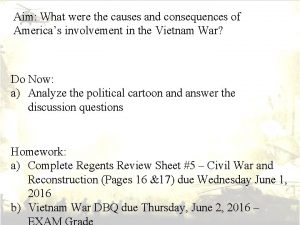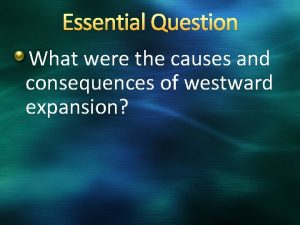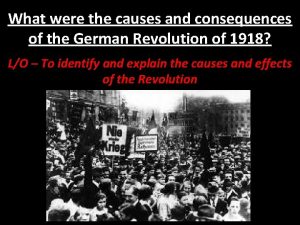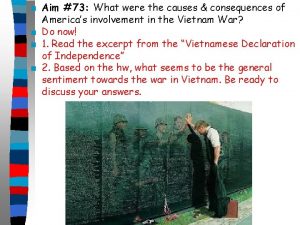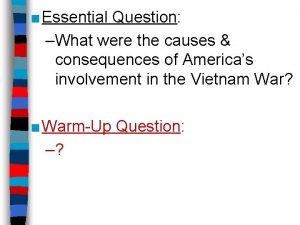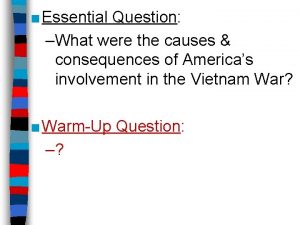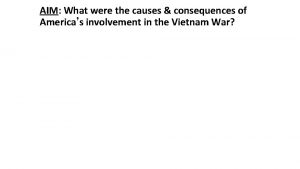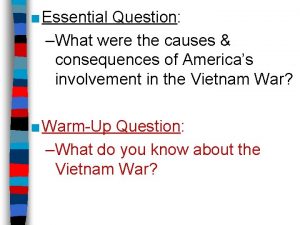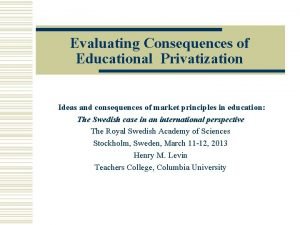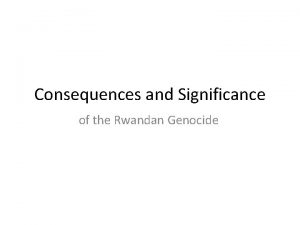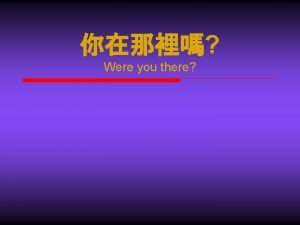What were the causes and consequences of the


















- Slides: 18

What were the causes and consequences of the ‘Great Leap Forward’? L/O – To be able to recall the reasons for, key features and effects of the Great Leap Forward: 1958

What was the Great Leap Forward? • In 1958 Mao introduced a second five year plan which became known as the ‘Great Leap Forward’ (GLF). • He believed it was possible for China to overtake Britain as a leading industrial power within seven years and the USA soon after. • It was to be achieved through mass mobilisation but was really a gigantic experiment that ended with the death of over 20 million Chinese.

Why was a new plan needed? • Mao believed the first Five Year Plan was too slow and resulted in too much bureaucracy. • Mao envisaged a decentralisation of control to local Party cadres who would mobilise the masses across China. Why decentralise? • China could then achieve rapid and sustained economic growth that would take China from the stage of Socialism to the stage of Communism.

Reasons for the Great Leap Forward 1. Political - Mao wanted another revolution to take control of industry & agricultural away from middle class ‘experts’. 2. Social - Still a lot of unemployment and Mao believed he could mobilise the masses in a continuing revolution to boost growth. Private family life would prevent this so had to abolished. 3. Economic - Was determined to turn China into a powerful industrial nation as quickly as possible. Greater factory and agricultural production was needed.

Key Features: Communes • Mass mobilisation was achieved by a new method of organising peasant life – the commune. He wanted to abolish the private, family sphere of peasant life. • Collective and Co-operative farms were joined into 24, 000 communes with a population of 30, 000 people each. • People in communes were organised into brigades of workers between 1000 -2000 and then teams of workers of 50 -200.


Key Features: Communes • The government tried to persuade people to join communes by using propaganda. By 1958, the whole of China was organised into communes with about 700 million people. • They seemed the ideal way to organise China’s peasant labour force: • They were large enough to tackle large projects like irrigation and could run their own local schools and clinics. • They also set up their own local industries to mine coal and iron and make steel in blast furnaces. • Life in the commune was lived communally. Peasants ate in mess halls and nurseries looked after children.

Key Features: Party Propaganda • A key element in the GLF was Party propaganda. Posters, slogans and newspaper articles were all used to encourage mass enthusiasm and long hours of work. • Loudspeakers played revolutionary music and stirring speeches encouraging workers to go beyond targets. • As a result of Party propaganda, many projects were finished on time.

Key Features: Industry • New industries were set-up in cities to solve unemployment. Increasingly higher targets for production were set. • Central, rational planning was abandoned in favour of local organisation. Small commune factories were set up to make all kinds of products like cement, ball-bearing and fertiliser. • Great emphasis was placed on the production of steel and the establishment of 600, 000 ‘backyard’ steel furnaces in towns and villages.



Key Features: Industry • In Autumn 1957, he declared that China would produce 40 million tonnes of steel by 1970. • In Autumn 1958, he predicted 700 million tonnes of steel by 1970! • As Mao’s confidence grew, his expectations were raised even higher. Mao just kept setting even higher targets. Critics didn’t want to labelled as ‘rightists’ so no one questioned Mao.

Results of the GLF - Industry 1. Thousands of small factories was just wasteful and inefficient. Most of the steel produced in ‘backyard’ furnaces was rubbish. 2. Furnaces took too much of the countries coal supply and trains could not operate! 3. Party workers urged people to work faster and produce more steel to make themselves look good – this meant machines broke down and workers fell asleep at machines.

Results of the GLF - Agriculture 1. Food production slumped because too many peasants had moved into industry. 2. By 1961, China was having to import grain and impose rationing. Bad farming methods, floods and droughts caused bad harvests for three years. 3. The harvest of 1960 was reduced by 144 million tonnes due to the GLF. Between 1959 -1962, over 20 million Chinese starved to death.

Results of the GLF - Communes 1. Most proved too large to be run efficiently as they were hurriedly constructed by Party cadres keen to impress. 2. Peasants resented the loss of private plots and the attack on family life. 3. Members could not own private property, all received the same wages and families were broken up. This meant that members had no incentive to work hard and production actually fell!

Why did it fail? 1. Natural disasters affected the harvests. In 1960 northern China had a drought whilst there was serious flooding the south of the country. 2. Mao fell out with Khrushchev and in 1960 ordered all Soviet economic and scientific advisors back to the USSR. China was short of educated technicians. 3. Mainly Mao’s fault - He was in too much of a hurry and did not think about practical problems. 4. It was stupid! Mao rejected capital investment, technology and planning as revisionist and wrong! He was afraid of losing control of the revolution to experts.

Consequences of the GLF 1. Famine caused by the bad planning of the GLF and bad harvests resulted in over 20 million deaths and widespread Cannibalism! 2. China had to import food which undermined Mao’s aim of ‘self-reliance’ that the GLF was supposed to achieve. 3. Mao took part of the blame for the failure of the GLF, and in late 1958, resigned as head of state.

Consequences of the GLF • China was now controlled by three leading communists: • President, Liu Shao-chi • Prime Minister, Chou En-lai • The CCP General Secretary, Deng Xiaoping • They all tried to abandon the GLF by closing down ‘backyard’ factories, returning workers to farming, giving private land back to farmers and reducing communes to one-third of original size.
 Rising food prices causes and consequences
Rising food prices causes and consequences Persian wars cause
Persian wars cause What were the causes of the french and indian war
What were the causes of the french and indian war What was the causes of the french and indian war
What was the causes of the french and indian war What were the causes and effects of the vietnam war
What were the causes and effects of the vietnam war Proximate cause and ultimate cause
Proximate cause and ultimate cause Proximate behaviour in animals
Proximate behaviour in animals Was/were going to and was/were supposed to
Was/were going to and was/were supposed to Cause of colonialism
Cause of colonialism Sherman neckties
Sherman neckties Simulateries
Simulateries What were the causes of imperialism
What were the causes of imperialism What were the main reasons for ww1
What were the main reasons for ww1 What were the 4 main causes of the civil war
What were the 4 main causes of the civil war What were the causes of the mexican revolution
What were the causes of the mexican revolution What were the causes of imperialism
What were the causes of imperialism Causes of ww1 mania
Causes of ww1 mania Cause of korean war
Cause of korean war What were the causes of the korean war
What were the causes of the korean war
